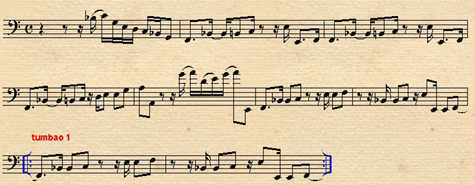Indice - Table of contents
New Stuff[hide]
Grupos: Ritmo Oriental : 1988 - Vol. IX - 30 a...
Musicos: Rafael Paseiro Monzón
Musicos: Dennis Nicles Cobas
Musicos: Jiovanni Cofiño Sánchez
Musicos: Yasser Morejón Pino
Fotos: Tom Ehrlich : 2024 Monterey Jazz, P...
Resenas: Vacilón Santiaguero (Circle 9 ...
Staff: Bill Tilford
Fotos: Tom Ehrlich : 2024 Monterey Jazz, P...
Fotos: Tom Ehrlich : 2024 Monterey Jazz Fe...
Fotos: Tom Ehrlich : testing 123
Grupos: Pupy y los que S... : Discography - 1995- F...
Reportes: From The St... : Cubadisco 2...
Reportes: From The St... : Jazz Plaza ...
Photos of the Day [hide]
The Music of Ritmo Oriental - Pero soy así
1977 Ritmo Oriental - Pero soy así (Tony Lamas)
bass: Humberto Perera - arranger: Humberto Perera
source: write EGREM
xx0x 0xxx 0xx0 xxx0 2-3 rumba clave
xxx0 0x0x xxx0 0x0x
xxx0 0x0x x0x0 0x0x tumbao 1 -- MIDI
By the late 70s, bombo-ponche bass tumbaos like tumbao 1 were becoming more and more common. Humberto makes this one interesting by switching octaves and, as he often did, by marking the clave every other time with an extra melodic note on the quinto pulse.
The bass playing is so beautiful on the transition from the cuerpo to tumbao 1 that it cries out to be transcribed note for note:
 Pero soy así - transition from cuerpo to tumbao 1 audio -- MIDI
Pero soy así - transition from cuerpo to tumbao 1 audio -- MIDI
Humberto plays endless variations of tumbao 1 as the arrangement progresses through several coros and a nice set of (non-con efecto) bloques.
The last tumbao could be thought of as yet another variation of the first, but Humberto inserts what in classical music is called a "deceptive cadence". Instead of playing C (in the key of C), he plays A, the relative minor (the underlined note is the deceptive cadence).
normal cadence (I - IV - V - I) (C - F - G - C)
deceptive cadence (I - IV - V - vi) (C - F - G - Ami)
Since all of the notes in the I chord fit with the vi chord, the bassist can force a deceptive cadence by changing one note without any action on the part of the other instruments, (although in this case the strings do change). As such, it's become a part of the bag of tricks of almost every Latin bassist, but this is the earliest example I've stumbled on.
xx0x 0xxx 0xx0 xxx0 2-3 rumba clave
0xx0 x0x0 x00x 00xx
0xx0 x0x0 x00x 00xx string guajeo (underlined notes unique to t2)
xxxx xxxx xxx0 0x0x
xxx0 0x0x x0x0 0x0x
x0xx 0xx0 xxx0 0x0x tumbao 2 -- MIDI -- MIDI w/strings
The catchy string guajeo maintains the same rhythm throughout the track, but changes its notes when the bass switches to tumbao 2 to enhance the deceptive cadence.





















